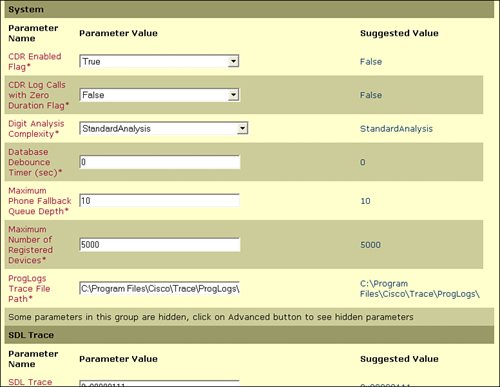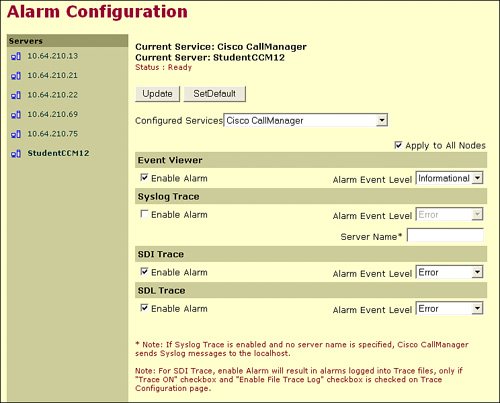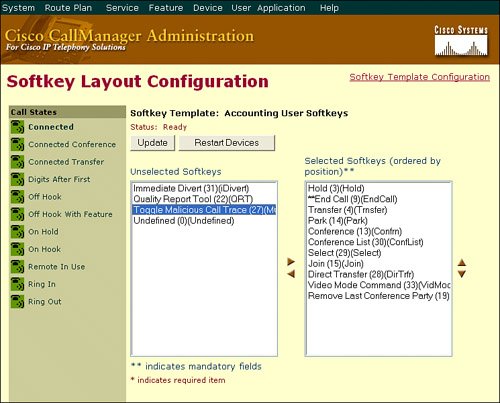Malicious Call Identification
Malicious Call Identification (MCID), available starting with Cisco CallManager Release 4.0, is an internetwork service that allows users to initiate a sequence of events when they receive calls with a malicious intent from another network (typically, the PSTN). The user who receives a disturbing call can invoke the MCID feature by using a softkey or feature code while connected to the call. The MCID service immediately flags the call as a malicious call with an alarm notification to the Cisco CallManager administrator. The MCID service flags the CDR with the MCID notice and sends a notification to the off-net PSTN that a malicious call is in progress.
The MCID service is an ISDN PRI service, when using PRI connections to the PSTN. The MCID service includes two components:
- MCID-O An originating component that invokes the feature at the request of the user (victim) and that sends the invocation request to the connected network
- MCID-T A terminating component that receives the invocation request from the connected network and responds with a success or failure message that indicates whether the service can be performed
Typically, each function runs in separate network entities, and the two service components communicate with each other to allow two networks to identify a call as malicious.
Cisco CallManager supports only the originating component at this time.
Tip
MCID is a PRI-based service. If your organization does not use PRI PSTN connections, MCID can still flag calls with malicious intent in the CallManager CDRs.
Configuring MCID
MCID, which is a system feature, comes standard with Cisco CallManager software. MCID does not require special installation or activation.
To configure MCID, follow these general procedures:
|
Step 1. |
Ensure that the CDR flag is set to True. |
|
Step 2. |
Configure the alarm. |
|
Step 3. |
Configure a softkey template with the Malicious Call Trace softkey. |
|
Step 4. |
Assign the MCID softkey template to an IP Phone. |
|
Step 5. |
Notify users that the MCID feature is available. |
Configuring CallManager to Support CDRs
To enable Cisco CallManager to flag a CDR with the MCID indicator, you must enable the CDR flag. Use the following procedure in Cisco CallManager Administration to enable the CDR flag:
|
Step 1. |
From the drop-down list, choose Service > Service Parameters. |
|
Step 2. |
Choose the Cisco CallManager server name. |
|
Step 3. |
In the Service field, choose Cisco CallManager. The Service Parameters Configuration window appears. |
|
Step 4. |
In the System area, set the CDR Flag Enabled field to True if it is not already enabled, as shown in Figure 17-18. Figure 17-18. Configuring CallManager Service Parameters to Support CDRs 
|
|
Step 5. |
If you have made a change, click Update. |
Configuring MCID Alarms
To provide for the MCID alarm information to appear in the Event Viewer, you need to enable the alarm event level. Use Cisco CallManager Serviceability and the following procedure to activate alarms for MCID:
|
Step 1. |
Choose Application > Serviceability. The Cisco CallManager Serviceability application opens. |
|
Step 2. |
Choose Alarm > Configuration. The Alarm Configuration window is displayed. |
|
Step 3. |
From the list, choose the Cisco CallManager server. |
|
Step 4. |
In the Configured Services drop-down list, choose Cisco CallManager. The Alarm Configuration window updates with configuration fields. |
|
Step 5. |
Under Event Viewer, in the Alarm Event Level drop-down list, choose Informational, as shown in Figure 17-19. Figure 17-19. Configuring MCID Alarms in Windows 2000 Event Viewer 
|
|
Step 6. |
Under Event Viewer, check the Enable Alarm check box. |
|
Step 7. |
If you want to enable the alarm for all nodes in the cluster, check the Apply to All Nodes check box. |
|
Step 8. |
Click Update to turn on the informational alarm. |
Adding the MCID Softkey
For users to trigger MCID alerts, you must add the appropriate softkey to the softkey template configured for their IP Phones. Use this procedure in Cisco CallManager Administration to add the Malicious Call softkey to a template:
|
Step 1. |
Choose Device > Device Settings > Softkey Template. The Find and List Softkey Templates window appears. |
|
Step 2. |
Select the Softkey Template assigned to your users. If your users are using one of the built-in softkey templates, you will need to create a new softkey template, as described in Chapter 16, "Configuring User Features, Part 1." |
|
Step 3. |
In the upper-right corner of the window, click the Configure Softkey Layout link. The Softkey Layout Configuration window appears. |
|
Step 4. |
In the Call States area on the left, choose Connected. The list in the Unselected Softkeys pane changes to display the available softkeys for this call state. |
|
Step 5. |
In the Unselected Softkeys pane, choose Toggle Malicious Call Trace, as shown in Figure 17-20. Figure 17-20. Adding the MCID Softkey 
|
|
Step 6. |
To move the softkey to the Selected keys pane, click the right arrow. |
|
Step 7. |
Click Update to ensure that the softkey template is configured. |
Part I: Cisco CallManager Fundamentals
Introduction to Cisco Unified Communications and Cisco Unified CallManager
Cisco Unified CallManager Clustering and Deployment Options
- Cisco Unified CallManager Clustering and Deployment Options
- The Two Sides of the Cisco Unified CallManager Cluster
- Cluster Redundancy Designs
- Call-Processing Deployment Models
- Summary
- Review Questions
Cisco Unified CallManager Installation and Upgrades
- Cisco Unified CallManager Installation and Upgrades
- Cisco Unified CallManager 4.x Clean Installation Process
- Upgrading Prior Cisco Unified CallManager Versions
- Summary
- Review Questions
Part II: IPT Devices and Users
Cisco IP Phones and Other User Devices
Configuring Cisco Unified CallManager to Support IP Phones
- Configuring Cisco Unified CallManager to Support IP Phones
- Configuring Intracluster IP Phone Communication
- IP Phone Configuration
- Case Study: Device Pool Design
- Summary
- Review Questions
Cisco IP Telephony Users
- Cisco IP Telephony Users
- Cisco CallManager User Database
- Cisco CallManager User Configuration
- User Logon and Device Configuration
- Summary
- Review Questions
Cisco Bulk Administration Tool
- Cisco Bulk Administration Tool
- The Cisco Bulk Administration Tool
- Using the Tool for Auto-Registered Phone Support
- Summary
- Review Questions
Part III: IPT Network Integration and Route Plan
Cisco Catalyst Switches
- Cisco Catalyst Switches
- Catalyst Switch Role in IP Telephony
- Powering the Cisco IP Phone
- Data and Voice VLANs
- Configuring Class of Service
- Summary
- Review Questions
Configuring Cisco Gateways and Trunks
- Configuring Cisco Gateways and Trunks
- Cisco Gateway Concepts
- Configuring Access Gateways
- Cisco Trunk Concepts
- Configuring Intercluster Trunks
- SIP and Cisco CallManager
- Summary
- Review Questions
Cisco Unified CallManager Route Plan Basics
- Cisco Unified CallManager Route Plan Basics
- External Call Routing
- Route Plan Configuration Process
- Summary
- Review Questions
Cisco Unified CallManager Advanced Route Plans
- Cisco Unified CallManager Advanced Route Plans
- Route Filters
- Discard Digit Instructions
- Transformation Masks
- Translation Patterns
- Route Plan Report
- Summary
- Review Questions
Configuring Hunt Groups and Call Coverage
- Configuring Hunt Groups and Call Coverage
- Call Distribution Components
- Configuring Line Groups, Hunt Lists, and Hunt Pilots
- Summary
- Review Questions
Implementing Telephony Call Restrictions and Control
- Implementing Telephony Call Restrictions and Control
- Class of Service Overview
- Partitions and Calling Search Spaces Overview
- Time-of-Day Routing Overview
- Configuring Time-of-Day Routing
- Time-of-Day Routing Usage Scenario
- Summary
- Review Questions
Implementing Multiple-Site Deployments
- Implementing Multiple-Site Deployments
- Call Admission Control
- Survivable Remote Site Telephony
- Summary
- Review Questions
Part IV: VoIP Features
Media Resources
- Media Resources
- Introduction to Media Resources
- Conference Bridge Resources
- Media Termination Point Resources
- Annunciator Resources
- Transcoder Resources
- Music on Hold Resources
- Media Resource Management
- Summary
- Review Questions
Configuring User Features, Part 1
- Configuring User Features, Part 1
- Basic IP Phone Features
- Softkey Templates
- Enhanced IP Phone Features
- Barge and Privacy
- IP Phone Services
- Summary
- Review Questions
Configuring User Features, Part 2
- Configuring User Features, Part 2
- Cisco CallManager Extension Mobility
- Client Matter Codes and Forced Authentication Codes
- Call Display Restrictions
- Malicious Call Identification
- Multilevel Precedence and Preemption
- Summary
- Review Questions
Configuring Cisco Unified CallManager Attendant Console
- Configuring Cisco Unified CallManager Attendant Console
- Introduction to Cisco CallManager Attendant Console
- Call Routing and Call Queuing
- Server and Administration Configuration
- Cisco Attendant Console Features
- Summary
- Review Questions
Configuring Cisco IP Manager Assistant
- Configuring Cisco IP Manager Assistant
- Cisco IP Manager Assistant Overview
- Cisco IP Manager Assistant Architecture
- Configuring Cisco IPMA for Shared-Line Support
- Summary
- Review Questions
Part V: IPT Security
Securing the Windows Operating System
- Securing the Windows Operating System
- Threats Targeting the Operating System
- Security and Hot Fix Policy
- Operating System Hardening
- Antivirus Protection
- Cisco Security Agent
- Administrator Password Policy
- Common Windows Exploits
- Security Taboos
- Summary
- Review Questions
Securing Cisco Unified CallManager Administration
- Securing Cisco Unified CallManager Administration
- Threats Targeting Remote Administration
- Securing CallManager Communications Using HTTPS
- Multilevel Administration
- Summary
- Review Questions
Preventing Toll Fraud
- Preventing Toll Fraud
- Toll Fraud Exploits
- Preventing Call Forward and Voice-Mail Toll Fraud Using Calling Search Spaces
- Blocking Commonly Exploited Area Codes
- Using Time-of-Day Routing
- Using FAC and CMC
- Restricting External Transfers
- Dropping Conference Calls
- Summary
- Review Questions
Hardening the IP Phone
Understanding Cryptographic Fundamentals
- Understanding Cryptographic Fundamentals
- What Is Cryptography?
- Symmetric Encryption
- Asymmetric Encryption
- Hash Functions
- Digital Signatures
- Summary
- Review Questions
Understanding the Public Key Infrastructure
- Understanding the Public Key Infrastructure
- The Need for a PKI
- PKI as a Trusted Third-Party Protocol
- PKI Entities
- PKI Enrollment
- PKI Revocation and Key Storage
- PKI Example
- Summary
- Review Questions
Understanding Cisco IP Telephony Authentication and Encryption Fundamentals
- Understanding Cisco IP Telephony Authentication and Encryption Fundamentals
- Threats Targeting the IP Telephony System
- How CallManager Protects Against Threats
- PKI Topologies in Cisco IP Telephony
- PKI Enrollment in Cisco IP Telephony
- Keys and Certificate Storage in Cisco IP Telephony
- Authentication and Integrity
- Encryption
- Summary
- Review Questions
Configuring Cisco IP Telephony Authentication and Encryption
- Configuring Cisco IP Telephony Authentication and Encryption
- Authentication and Encryption Configuration Overview
- Enabling Services Required for Security
- Using the CTL Client
- Working with Locally Significant Certificates
- Configuring the Device Security Mode
- Negotiating Device Security Mode
- Generating a CAPF Report
- Summary
- Review Questions
Part VI: IP Video
Introducing IP Video Telephony
- Introducing IP Video Telephony
- IP Video Telephony Solution Components
- Video Call Concepts
- Video Protocols Supported in Cisco CallManager
- Bandwidth Management
- Call Admission Control Within a Cluster
- Call Admission Control Between Clusters
- Summary
- Review Questions
Configuring Cisco VT Advantage
- Configuring Cisco VT Advantage
- Cisco VT Advantage Overview
- How Calls Work with Cisco VT Advantage
- Configuring Cisco CallManager for Video
- Configuring Cisco IP Phones for Cisco VT Advantage
- Installing Cisco VT Advantage on a Client
- Summary
- Review Questions
Part VII: IPT Management
Introducing Database Tools and Cisco Unified CallManager Serviceability
- Introducing Database Tools and Cisco Unified CallManager Serviceability
- Database Management Tools
- Cisco CallManager Serviceability Overview
- Tools Overview
- Summary
- Review Questions
Monitoring Performance
- Monitoring Performance
- Performance Counters
- Microsoft Event Viewer
- Microsoft Performance Monitor
- Real-Time Monitoring Tool Overview
- Summary
- Review Questions
Configuring Alarms and Traces
- Configuring Alarms and Traces
- Alarm Overview
- Alarm Configuration
- Trace Configuration
- Trace Analysis
- Trace Collection
- Bulk Trace Analysis
- Additional Trace Tools
- Summary
- Review Questions
Configuring CAR
- Configuring CAR
- CAR Overview
- CAR Configuration
- Report Scheduling
- System Database Configuration
- User Report Configuration
- Summary
- Review Questions
Using Additional Management and Monitoring Tools
- Using Additional Management and Monitoring Tools
- Remote Management Tools
- Dependency Records
- Password Changer Tool
- Cisco Dialed Number Analyzer
- Quality Report Tool
- Summary
- Review Questions
Part VIII: Appendix
Appendix A. Answers to Review Questions
Index
EAN: 2147483647
Pages: 329
